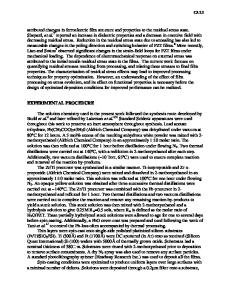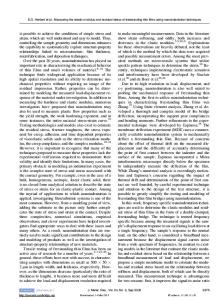Residual stress in fiber-textured thin films of cubic materials
- PDF / 258,386 Bytes
- 10 Pages / 612 x 792 pts (letter) Page_size
- 77 Downloads / 315 Views
The effect of fiber texture on the x-ray residual stress analysis in thin films of cubic materials is discussed according to different mechanical models. The x-ray elastic constants (XECs) were calculated from single-crystal elastic constants for Cu, cubic ZrO2, and TiN, in the case of a typical [111] fiber texture with different spread of orientations [expressed by the half-width at half-maximum of the (111) pole figure]. Calculations were performed according to Reuss, Voigt, and Hill models, considering different crystallographic directions in cubic structures, in order to underline the effect of the mechanical anisotropy and fiber texture. The results clearly indicated the dependence of the XECs on the sample tilting angle, with the notable exception of [111] and [200], which were texture oscillation-free directions. Profiting from this condition the residual stress gradient in a fiber-textured TiN thin film deposited on stainless steel was determined by the simultaneous analysis of texture and residual strain for the (111) and (200) reflections. Advantages and limits of the procedure are discussed together with the experimental results.
I. INTRODUCTION
X-ray residual stress analysis (XRSA) is frequently used to study the residual stress field in polycrystalline materials. The technique is well established for untextured bulk materials and is frequently used in materials science studies as well as for industrial quality control.1– 4 XRSA is also used for thin films and coatings, even if in these cases the extension of conventional methods is not straightforward, and requires a deeper understanding of the relationship between microstructure and mechanical behavior. Accurate x-ray elastic constants (XECs) are essential in the determination of the stress state. Although XECs can be measured experimentally, the procedure can be quite long and demanding, so XECs of polycrystalline materials are usually calculated from stiffness (cij) [or compliance (sij)] tensor data for the corresponding single crystal. In this case it is necessary to introduce some hypothesis on the mechanism of mechanical coupling between grains. Different models, like those of Reuss, Voigt, Hill, and Kro¨ner, have been considered,1,2,5–8 and the XECs for quasi-isotropic materials (also termed macroscopically isotropic; i.e., texture-free materials with sufficiently small crystalline domains) calculated under these models are well known, and can be routinely obtained using simple formulas.1 For some special cases of
a)
Address all correspondence to this author. e-mail: [email protected] J. Mater. Res., Vol. 16, No. 1, Jan 2001
http://journals.cambridge.org
Downloaded: 14 Mar 2015
preferred orientation, such as the very sharp texture typical of epitaxial thin films, XECs can be calculated from single-crystal data, 9 for instance by the so-called “crystallite group method.”2 In the more general case XECs should be calculated from the single-crystal data taking into account the orientation distribution function (ODF),10 which quantitat
Data Loading...









